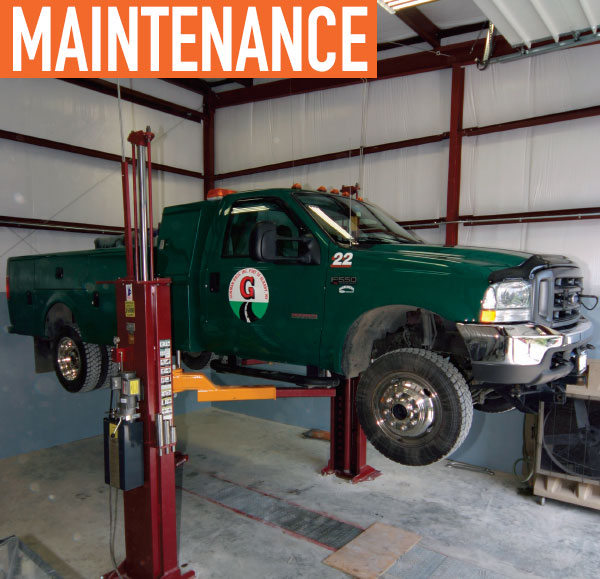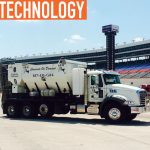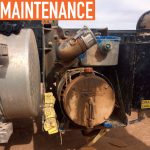As a fleet manager, you acknowledge you’ll never have 100 percent of your fleet on the road given PMs and normal repairs. Although 100 percent of your fleet’s usage is impossible, it is possible to keep more of your fleet on the street by getting vehicles in and out of your shop faster than you might currently be doing. These increases in shop productivity can equate to the equipment used to repair and service your fleet:
MOBILE LIFTS
Many shops use the very popular mobile column lifts. Mobile column lifts operate with one of two types of lifting methods: electro-hydraulic, using a motor/pump and cylinder, or electro-mechanical where a motor and screw gear drive the lift up and down. Relative to shop productivity, an electro-mechanical lift takes between two and three minutes to fully raise a vehicle and the same amount of time to lower, depending on the brand. An electric-hydraulic lift takes about one minute up and one minute down. Therefore, the electro-mechanical mobile lifts take four to six minutes for a full up and down cycle, while electro-hydraulic lifts raise and lower in about two minutes.
When we consider, for example, that a shop raises its vehicles just four times a day, the difference in the electro-hydraulic lift means eight minutes operating the lifts control buttons versus 16 or 24 minutes. Multiplied over a five-day work week, this equates to 40 minutes using an electro-hydraulic lift or 34 hours operating the lift, annually. Conversely, an electro-mechanical mobile lift requires 80 to 120 minutes of operation, weekly. Annually, technicians raise and lower vehicles for 36 hours if using an electric-hydraulic lift versus 70 or 104 hours using the slower electro-mechanical lift. Think of the potential of your shop’s productivity if the technicians weren’t standing there holding the up or down buttons for an extra 46 or 68 hours per year! Then consider the same happens in year two, three, and so on. A shop’s productivity isn’t measured on how long a tech needs to hold the up or down button on any brand of lift. Make sure the mobile lifts you consider purchasing are as efficient as possible.
TWO-POST LIFTS
Let’s consider the most popular lift—a two-post, side-by-side frame engaging lift. The popularity of two-post lifts is based on minimal bay space used with the tires hanging free for tire, brake, and wheel service and complete under-vehicle access. All two-post lifts are equipped with four swing arms to engage the lifting points under the vehicle. It takes most technicians five to 10 minutes to position the four arms to raise the vehicle. This time varies by vehicle, yet in general, properly positioning the swing arms under a car are much easier than under a typical work truck.
To speed the process of positioning the swing arms, some lift manufacturers offer options that essentially allow a two-post swing arm lift to be quickly converted to a two-post drive-on lift, yet still leave the tires hanging free for repairs. This option saves technicians the set-up time of positioning the four swing arms.
TIRE TALK
Manual jobs such as brake inspection, tire wear, and tire pressure become time consuming for technicians. Each tire’s pressure must be checked, the treads inspected for unusual wear or damage, and each tire removed to visually inspect the brakes. These three tasks can be huge annual consumers of your technicians’ time. Enter the Hunter QUICKCHECK, a device that gives a readout of the tire treads, pressure, and brake performance of each tire just by driving the vehicle over the QUICKCHECK device.
When a tire is low or brakes are in need of maintenance or repair, the QUICKCHECK’s printout alerts technicians of a potential issue. If a vehicle’s brakes were recently serviced, it is likely that technicians are not checking brakes every time the vehicle drives into the shop. Yet with a properly positioned QUICKCHECK at the entry to the shop, you’ll always have completed a tire and brake inspection.
Fleets consume tires. It’s been that way forever. Regardless of the brand or quality of the tire, your fleet garage likely has a tire changer and wheel balancer. If you were to measure “book time” of a technician changing four tires on each vehicle in your fleet however many times per year, again, you would find that tire changing is a large annual consumer of your technicians’ time. Historically, the method for changing tires is to remove the tire, bring it to the tire changer, remove the tire from the rim, and then do the opposite to remount the tire. Consider using Hunter Engineering’s Revolution tire changer, which allows for a 25 percent time savings by allowing the technician to walk away from the tire changer while the machine does all the work.
BACK TO WORK
Although repairs and maintenance might keep fewer than 100 percent of your fleet on the road 100 percent of the time, incorporating these products in your shop creates a more efficient maintenance routine. Efficient shops mean a significant decrease in downtime, keeping your trucks on the road and working for you.
ABOUT THE AUTHOR
Steve Perlstein is the president and government sales manager of Mohawk Lifts.
MODERN WORKTRUCK SOLUTIONS: MAY 2018 ISSUE
Did you enjoy this article?
Subscribe to the FREE Digital Edition of Modern WorkTruck Solutions magazine.
![]()





